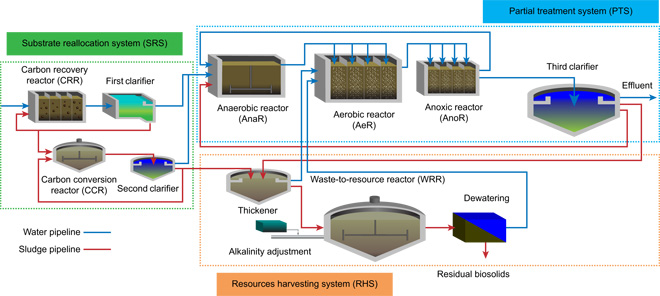New research from an international team, led by water engineers from the University of Exeter, has provided a method to incorporate ecological processes into water treatment facilities, allowing for a more environmentally friendly design.
Published in the journal Science Advances, the technique described in the paper, Evolving wastewater infrastructure paradigm to enhance harmony with nature, centres around creating a distinctive water system that uses both artificial and natural systems. The technique incorporates both systems into the treatment pipeline, transforming potentially harmful elements, such as carbon, phosphorus, and nitrogen from wastewater, into renewable energy and materials.
“Existing design schemes for wastewater systems focus merely on the technologies,” said Professor Xu Wang, co-author of the paper and part of Exeter’s Centre for Water Systems. “If the system design could benefit from the abilities of nature, it could ensure infrastructure development within ecological constraints and could maximize other benefits.”
The researchers believe that the system, called REPURE, has the potential to revolutionize wastewater systems used for agriculture and energy production worldwide.
“Our REPURE design includes the carbon capture and nutrient retention services provided by soils, as they were found to help reduce adverse environmental effects during the land use of the biosolids and reclaimed water,” said Wang. “More importantly, this new design can be promoted in many places, as soil is a major component of the planet and exists in nearly every country.”

At present, removing pollutants from wastewater requires a large amount of energy. Recent figures showed that 38 per cent of the energy used by municipalities in Ontario is consumed by water and wastewater systems. In addition, recent estimates point out that approximately 20 per cent of the global demand for phosphate could be met by recovering phosphorus from waste.
“Our findings indicated that a systems integration approach to develop complete systems allowed this ongoing revolution to produce significantly superior outcomes in a real-world context,” wrote the researchers. “This is in contrast to a more traditional approach based on the qualitative assumption that ‘more is better’, in which simply adding many alternative options is believed to lead to a sustainable wastewater treatment system.”
Furthermore, the authors note the relevance of such an integrated systems design with respect to the UN SDG deadline of 2030: “Given the time frame of less than 13 years, progress toward achieving the SDGs requires the effective conversion of evolving knowledge into practical solutions.”
The researchers believe that the new REPURE design would allow wastewater to be treated without the need for any energy at all, and also significantly reduce the carbon footprint of the systems, as well as provide attractive feedstocks for productions of renewable energy, fertilizers, biopolymers and other green chemicals.
“Restoring and improving harmony between human activities and nature is essential to human well-being and survival, and the role of wastewater infrastructure is evolving towards resource recovery to address this challenge,” said professor David Butler, a co-author of the study. “This integrative study advances our understanding and approaches of how to regain the balance between satisfying human demands and maintaining ecosystems.”








